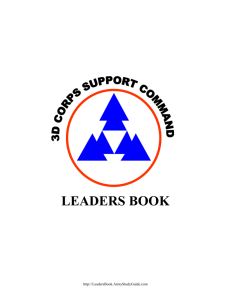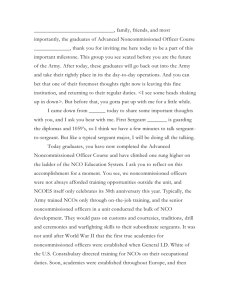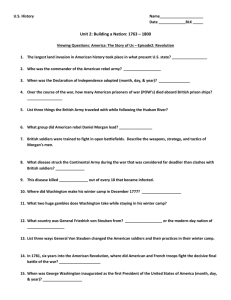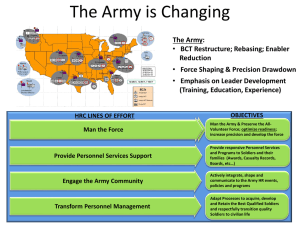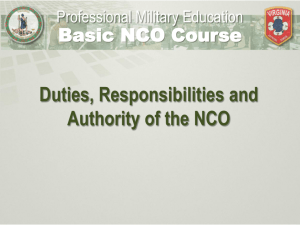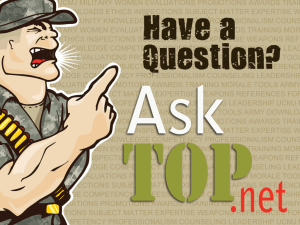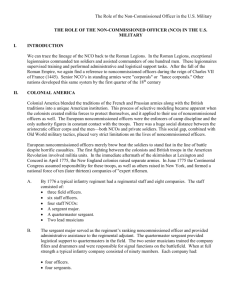TRAINING SUPPORT PACKAGE (TSP)
advertisement
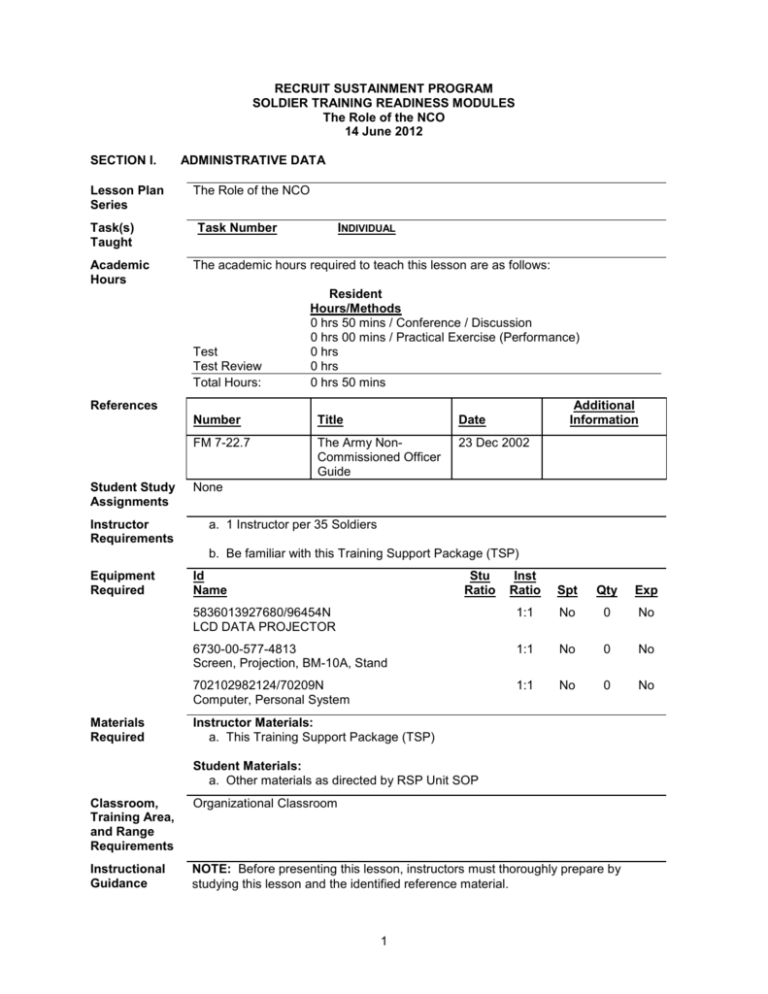
RECRUIT SUSTAINMENT PROGRAM SOLDIER TRAINING READINESS MODULES The Role of the NCO 14 June 2012 SECTION I. Lesson Plan Series Task(s) Taught Academic Hours ADMINISTRATIVE DATA The Role of the NCO Task Number INDIVIDUAL The academic hours required to teach this lesson are as follows: Test Test Review Total Hours: Resident Hours/Methods 0 hrs 50 mins / Conference / Discussion 0 hrs 00 mins / Practical Exercise (Performance) 0 hrs 0 hrs 0 hrs 50 mins References Student Study Assignments Instructor Requirements Additional Information Number Title Date FM 7-22.7 The Army NonCommissioned Officer Guide 23 Dec 2002 None a. 1 Instructor per 35 Soldiers b. Be familiar with this Training Support Package (TSP) Equipment Required Materials Required Id Name Stu Ratio Inst Ratio Spt Qty Exp 5836013927680/96454N LCD DATA PROJECTOR 1:1 No 0 No 6730-00-577-4813 Screen, Projection, BM-10A, Stand 1:1 No 0 No 702102982124/70209N Computer, Personal System 1:1 No 0 No Instructor Materials: a. This Training Support Package (TSP) Student Materials: a. Other materials as directed by RSP Unit SOP Classroom, Training Area, and Range Requirements Organizational Classroom Instructional Guidance NOTE: Before presenting this lesson, instructors must thoroughly prepare by studying this lesson and the identified reference material. 1 SECTION II. INTRODUCTION Method of Instruction: Conference / Discussion Instructor to Student Ratio is: 1:35 Time of Instruction: 5 mins Media: None Motivator Noncommissioned Officers are the backbone of The Army and the reason our Army is the best trained, most professional, and most respected in the world. First-line supervisors execute day-to-day operations with precision whenever and wherever duty calls. NCOs provide the leadership required to fulfill our nonnegotiable contract with the American people - to fight and win our Nation's wars, decisively. Living, implementing and teaching the NCO Creed in your duties will further instill and develop those critical leadership skills that our Army and our Nation require and deserve as we train Soldiers and grow leaders. Terminal Learning Objective NOTE: Inform the students of the following Terminal Learning Objective requirements. At the completion of this lesson, you [the student] will: Action: Explain the role of the Noncommissioned Officer Conditions: Safety Requirements Given the duties, responsibilities and authority of the Noncommissioned Officer Standards: Correctly explain the duties, responsibilities, and authority of the Noncommissioned Officers Conduct a safety brief prior to training as needed and IAW unit and installation policies. Risk Assessment Level Low - Risk Assessment to be produced locally IAW FM 5-19, August 2006. Evaluation None Instructional Lead-In As a Noncommissioned Officer you will be a “Servant to the Nation” and will be held liable under the Uniformed Code of Military Justice, not only to enforce and execute the authority, responsibility and duty of the office you will enter, but also maintain discipline throughout the ranks. NCOs make it happen - they inspire Soldiers to work toward common goals, lead from the front and provide an example of what right looks like. They do not walk by deficiencies either in training or in individual departures from the Army Values - NCOs are the front line in enforcing and reinforcing our institutional values. As a “Warrior” you must train Soldiers and apply violence of action to accomplish the Army’s missions against the Global War on Terrorism. This can only be done with enforcing authority, leaders taking responsibility for their actions, and the daily duties that govern our military are executed without hesitation. 2 SECTION III. 1. PRESENTATION Learning Step / Activity 1. Duties Method of Instruction: Conference / Discussion Instructor to Student Ratio: 1:35 Time of Instruction: 15 mins Media: None a. What's Duty? (1) A legal or moral obligation by virtue of one’s position. (2) Accomplishing all assigned tasks to the fullest of one’s ability. (3) A willingness to accept responsibility for ones actions and subordinates’ performance. (4) Taking initiative without being told to do so. b. Types of Duties. (1) Specified Duties: Are those related to jobs and positions such as Army Regulations, Department of the Army (DA) General Orders, Uniform Code of Military Justice (UCMJ), Army Training and Evaluation Program (ARTEP) publications, and MOS job descriptions. (2) Directed Duties: Are not specified as part of a job position, MOS, or other directive. These are assigned by a superior orally or in writing to a subordinate (e.g., Charge of Quarters (CQ) or Company Training NCO) (3) Implied Duties: Essential to the day-to-day operation of the Army and depends on individual initiative in keeping the unit functional at an optimum level. c. Duties of NCOs. (1) Conducts the daily business of the Army within established policy. (2) Focuses on individual training that leads to mission capability. (3) Is primarily involved with individual Soldier and team leading. (4) Ensures subordinate Soldiers and their equipment are prepared to function as effective unit members. (5) Concentrates on the standards of performance, training, and professional development of Commissioned Officers, Warrant Officers, and Noncommissioned Officers. 2. Learning Step / Activity 2. Responsibilities Method of Instruction: Conference / Discussion Instructor to Student Ratio: 1:35 Time of Instruction: 15 mins Media: None a. Responsibility, what does it mean? 3 (1) Being accountable for what you do or fail to do. (2) NCOs are responsible to fulfill not only their individual duties, but also to ensure their teams and units are successful. b. Categories of Responsibility. (1) Individual Responsibility: Means you are accountable for your personal conduct. (2) Command Responsibility: Refers to collective or organizational accountability and includes how well the unit performs their missions. c. Differences between Commissioned, Warrant, and Noncommissioned Officers. (1) Commissioned Officers. (a) Commands, establishes policy. (b) Concentrates on collective training, which will enable the unit to accomplish its mission. (c) Is primarily involved with unit operations, training and related activities. (d) Concentrates on unit effectiveness and unit readiness. (e) Pays particular attention to the standards of performance, training and professional development of officers as well as NCOs. (2) Warrant Officers. (a) Provides quality advice, counsel and solutions to support the command. (b) Executes policy and manages the Army's system. (c) Commands special-purpose units and tasks-organized operational elements. (d) Focuses on collective, leader and individual training. (e) Operates, maintains, administers and manages the Army's equipment, support activities and technical system. (3) Noncommissioned Officers. (a) Conducts the daily business of the Army within established orders, directives and policies. (b) Focuses on individual training, which develops the capability to accomplish the mission. (c) Primarily involved with training and leading Soldiers and teams. (d) Ensures each subordinate team, NCO and Soldier are prepared to function as a effective unit and each team member is well trained, highly motivated, ready and functioning. 4 (e) Concentrates on standards of performance, training and professional development of NCOs and enlisted Soldiers. (f) Follows orders of officers and NCOs in the support channel. 3. Learning Step / Activity 3. Basis of Authority Method of Instruction: Conference / Discussion Instructor to Student Ratio: 1:35 Time of Instruction: 5 mins Media: None a. Authority is the legitimate power of leaders to direct Soldiers or to take action within the scope of their position. b. The types of authority are: (1) Command Authority: The authority leaders have over Soldiers by virtue of rank or assignment. (2) General Military Authority: Authority extended to all Soldiers to take action and act in the absence of a unit leader or other designated authority. c. Sources of authority are: (1) NCO. (2) Army Regulations (AR) and Manual for Courts Martial (MCM). (3) Chain of Command / NCO Support Channel. 4. Learning Step / Activity 4. Organizational Relationships Method of Instruction: Conference / Discussion Instructor to Student Ratio: 1:35 Time of Instruction: 5 mins Media: None a. Chain of Command: Is held accountable for all that the unit does or fails to do. Only by working together with the NCO Support Channel can Commanders assure the job will get accomplished. This is why the Chain of Command is kept informed of actions implemented through the NCO Support Channel and to eliminate the possibility of the NCO Support Channel operating outside of command policy and directives. b. NCO Support Channel: In addition to passing information, this channel is used for executing the Commander's orders and getting the job done. The NCO Support Channel assists the Chain of Command in accomplishing the following: (1) Transmitting, instilling and ensuring the efficacy of the professional Army ethic. (2) Planning and conducting the day-to-day unit operations within prescribed policies and directives. (3) Training enlisted Soldiers in their MOS as well as in the basic skills and attributes of a Soldier. 5 (4) Supervising unit physical fitness training and ensuring that Soldiers comply with the weight and appearance standards in AR 600-9 and AR 670-1. (5) Caring for individual Soldiers and their families both on and off duty. (6) Teaching Soldiers the mission of the unit and developing individual training programs to support the mission. (7) Accounting for and maintaining individual arms and equipment of enlisted Soldiers and unit equipment under their control. (8) Administering and monitoring the NCO professional development program and other unit training programs. (9) Advising the commander on rewards and punishment for enlisted Soldiers. TERMINAL LEARNING OBJECTIVE ACTION: Explain the role of the Noncommissioned Officer CONDITIONS: STANDARDS: Given the duties, responsibilities and authority of the Noncommissioned Officer Correctly explain the duties, responsibilities, and authority of the Noncommissioned Officers 6 SECTION IV. ASK FOR QUESTIONS AND SUMMARY Method of Instruction: Discussion Instructor to Student Ratio: 1:35 Time of Instruction: 5 mins Media: None a. Ask students if they have any questions. b. Answer all questions or agree to get back to students with a complete or appropriate answer. NOTE: SUMMARY Explain what you have discussed during this block of instruction, and offer any personal experiences to introduce the contemporary operating environment. 7 SECTION V. STUDENT EVALUATION (OPTIONAL) Testing Requirements None Feedback Requirements None 8 Appendix A - Viewgraph Masters (N/A) VIEWGRAPHS A-1 Appendix B - Test(s) and Test Solution(s) (N/A) B-1 Appendix C - Practical Exercises and Solutions (N/A) C-1 Appendix D - Student Handouts (N/A) D-1
